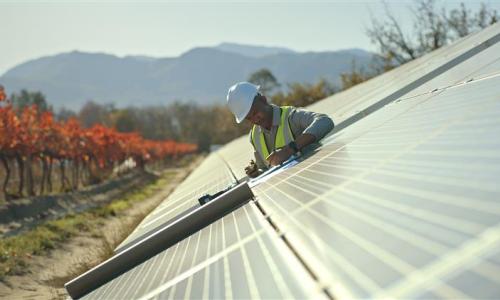The Wisconsin legislature is considering the Clean Energy Jobs Act (AB 649/SB 450), a comprehensive bill to increase energy efficiency and renewable energy based on recommendations from Governor Jim Doyle's Task Force on Global Warming. The bill includes a requirement for Wisconsin utilities to increase the use of wind, bioenergy, and other renewable energy sources from approximately 5 percent of the state's electricity use in 2009 to 25 percent by 2025.
Utilities must obtain 40 percent of this required renewable power from in-state facilities. Wisconsin is currently ahead of schedule in meeting its existing renewable electricity standard (also known as a renewable portfolio standard) of 10 percent by 2015. As of February 2010, renewable electricity standards have been adopted by 29 states, with 17 states having requirements of 20 percent or higher. Neighboring states Illinois and Minnesota have renewable electricity standards of 25 percent by 2025.
Using an updated model the Union of Concerned Scientists (UCS) originally developed for the University of Wisconsin and the Wisconsin energy office, and a separate model to calculate jobs impacts, we examined the costs and benefits of increasing Wisconsin's renewable electricity standard to 25 percent by 2025 under three different scenarios:
- the No Hydro Imports case assumes electricity from new, large-scale (greater than 60 megawatts) hydropower projects in Canada and other states do not contribute to the standard;
- the Hydro Imports case assumes electricity from new, large-scale hydro projects are imported into the state and contribute to the standard; and
- the No Renewable Energy Imports case assumes all new (post-2009) generation used to meet the standard comes from in-state renewable energy projects
Benefits
- Renewable energy development: 2,430 megawatts of new in-state capacity—mostly wind and biopower—equal to two-thirds of the new capacity needed to meet the standard
- Lower electricity bills: $59 million reduction in electricity bills—equivalent to reducing the average Wisconsin household bill by 60 cents per month
- Carbon reductions: Carbon emissions reductions equal to taking 2.1 million cars off the road
- Economic development: $2.4 billion in new capital investment. $630 million to farmers and rural areas from bioenergy production. $36 million in new local tax revenues.
- Job creation: 2,650 new jobs from renewable energy—5 times the number of jobs that would be created by producing the same amount of electricity with coal and natural gas
- Under the no hydro imports case
Consistent with other studies by UCS and the State of Wisconsin, we find that the Badger State has the resources to meet the 25 percent standard, while helping to protect consumers from rising electricity bills, create jobs, and cut global warming emissions. A more detailed description of the methodology, and the results of each scenario, can be found in the pdf fact sheet.



